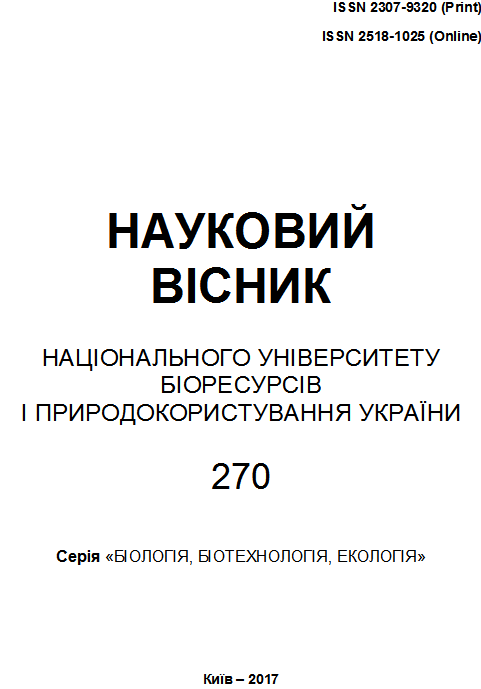FEATURES POWER SUPPLY OF TISSUES CARP CYPRINUS CARPIO L. FOR EXPOSURE TO HIGH WATER TEMPERATURE
Анотація
The peculiarities of power supply of various carp tissues under the influence of high water temperature are investigated. It was established that the processes of energy generation and energy consumption due to the unfavorable temperature factor in the tissues of the muscles, gills and liver of the mentioned species of fish are characterized by different intensity. In the muscles and gills, the content of adenine nucleotides at a temperature of 26°C is sharply reduced, whereas in the liver the change in the values of these indicators is not so pronounced. The ratio of ATP:ADP:AMP in almost all investigated tissues with a gradual increase in temperature from 24ºС to 34ºС is violated in the direction of increasing the proportion of AMP. In the case of adenylates energy charge, the results may indicate an inactivation of the ATP decomposition, as well as the inclusion of a compensatory mechanism of the carp by the body, aimed at preventing a decrease in the energy supply of tissues. The value of the main bioenergetic coefficients in the corresponding tissues at a temperature of 26°C is also reduced, but with a further rise in temperature to 34°C, the difference with the control decreases, which may indicate the development of adaptation to the adverse factor. The paper shows the dependence of the course of energy metabolism reactions, namely the exchange of adenylates, in carp tissues on the oscillatory regime of high water temperature. The obtained data indicate a different degree of energy supply of tissues of one organism under non-typical conditions.
Посилання
Asatiani V.S. (1965). Novye metody byokhymycheskoi fotometry. Moskow, Russia. [in Russian].
Golovanov V.K. (2007). Vliyaniye skorosti nagreva na termoustoychivost karpa Cyprinus carpio v razlichnyye sezony goda / V.K. Golovanov, V.K. Smirnov // Vopr. ikhtiologii. Moskow, Russia. 47 (4). 555–561.
Nahorna N.V. (2008). Enerhetychnyi obmin klityny v normi i patolohii. Mozhlyvosti yoho otsinky / N.V. Nahorna, N.A. Chetveryk, A.A. Fedorova. Klinichna herontolohiia. 6. 58.
Orlova O.A. (2009). Vplyv parafarmatsevtyka «Vin-Vita» na stan enerhetychnoho obminu v doroslykh shchuriv / O.A. Orlova, O.O. Lazarchuk. Ukrainskyi medychnyi almanakh. 12 (5). 124–128.
Romanenko V.D., Arsan O.M. & Solomatina V.D. (1991). Mekhanizmy temperaturnoy akklimatsii ryb. Kyiv, Ukraine. [in Russian].
Skulachev V.P. (1962). Sootnosheniye okisleniya i fosforilirovaniya v dykhatelnoy tsepi. Moskow, Russia. [in Russian].
Abraham J.P. (2013). A review of global ocean temperature observations: Implications for ocean heat content estimates andclimate change / J.P. Abraham. Rev. Geophys. 51 (3).450–483.
Atkinson D.E. (1971). Adenine nucleotides as universal stoichiometric metabolic coupling agents. Advances in enzyme regulations / ed. G. Weber. New York. 207–219.
Atkinson D.E. (1977). Cellular energy metabolism and its regulation. New York: Plenum Press. 235.
Atkinson D.E. (1968). The energy charge of the adenylate pools as a regulatory arameter. Interaction with feedback modifiers / D.E. Atkinson. Biochemistry. 7 (11). 4030–4034.
Becker C.D. (1979). Evaluation of the critical thermal maximum for determining thermal tolerance of freshwater fish / C.D. Becker, R.G. Genoway. Environ. Biol. Fish. 4 (3). 245–256.
Jobling M. (1981). Temperature tolerance and the final preferendum–rapid methods for the assessment of optimum growth temperature / M. Jobling. J. Fish. Biol. 19 (4). 439–455.
Seebacher F. (2009). Responses to temperature variation: integration of thermoregulation and metabolism in vertebrates / F. Seebacher. J. Exp. Biol. 212. 2885–2891.
Завантаження
Опубліковано
Номер
Розділ
Ліцензія
Стосунки між правовласниками і користувачами регулюються на умовах ліцензії Creative Commons Із Зазначенням Авторства – Некомерційна – Поширення На Тих Самих Умовах 4.0 Міжнародна (CC BY-NC-SA 4.0):https://creativecommons.org/licenses/by-nc-sa/4.0/deed.uk
Автори, які публікуються у цьому журналі, погоджуються з наступними умовами:
- Автори залишають за собою право на авторство своєї роботи та передають журналу право першої публікації цієї роботи на умовах ліцензії Creative Commons Attribution License, котра дозволяє іншим особам вільно розповсюджувати опубліковану роботу з обов'язковим посиланням на авторів оригінальної роботи та першу публікацію роботи у цьому журналі.
- Автори мають право укладати самостійні додаткові угоди щодо неексклюзивного розповсюдження роботи у тому вигляді, в якому вона була опублікована цим журналом (наприклад, розміщувати роботу в електронному сховищі установи або публікувати у складі монографії), за умови збереження посилання на першу публікацію роботи у цьому журналі.
- Політика журналу дозволяє і заохочує розміщення авторами в мережі Інтернет (наприклад, у сховищах установ або на особистих веб-сайтах) рукопису роботи, як до подання цього рукопису до редакції, так і під час його редакційного опрацювання, оскільки це сприяє виникненню продуктивної наукової дискусії та позитивно позначається на оперативності та динаміці цитування опублікованої роботи (див.The Effect of Open Access).

